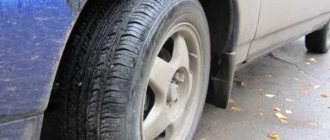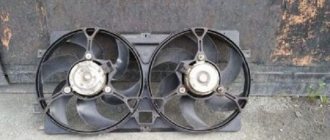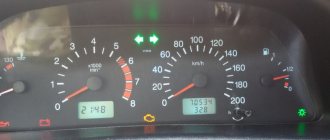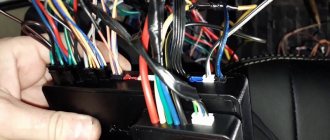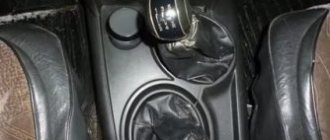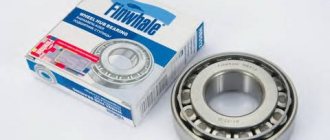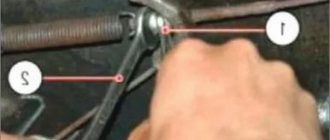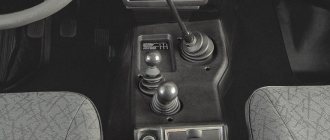- December 10, 2019
- Cars
- Vladimir Skvortsov
The favorite car of fishermen and hunters is the Niva. And the reason for this attitude is the opportunity with its help to get to remote and rarely visited places. What allows you to achieve such results? There is a lock on the Niva. How it helps and in what ways will be discussed below.
About the transmission
First of all, a few words about the structure of the Niva. It has permanent all-wheel drive. What does it mean? It's simple - torque is simultaneously transmitted to four wheels. This is one of the fundamental differences between the Niva and other cars. They supply torque to only one of the axles (front or rear).
All-wheel drive is implemented through the use of a transfer case. The torque, having passed through the gearbox, goes to the transfer case, and from it to the front and rear axles. This design makes it possible to create a locking center differential on the Niva, which, together with all-wheel drive, provides it with increased cross-country ability. Here it is necessary to say a few words about the differential. Largely thanks to him, the excellent off-road characteristics of the Niva are realized.
Transfer case alignment
Correct installation of the transfer case can be done in several ways. Most often in auto repair shops, repairmen use the following method:
- hang the car on a lift;
- loosen the transfer case;
- start the engine;
- engage the gear and accelerate the car according to the speedometer to the speed at which vibration occurs (often it occurs at speeds from 40 to 80 km/h);
- without using the brakes, reduce the engine speed, then turn off the ignition.
The transfer case itself is centered in place, all that remains is to tighten the fastenings of the supports.
You can also adjust the position of the RC using a wire; we do it as follows:
- loosen all four fastenings of the transfer case supports;
- fasten one end of the wire to the rubber coupling of the propeller shaft;
- we attach another piece of wire to the CV joint, bring the other ends of the wire to each other;
- rotate the shaft; if the transfer case is not centered, the ends of the wire will diverge during rotation;
- the task comes down to installing the transfer case using the selection method so that the ends of the wire practically do not diverge from each other in any position when turning the shaft.
Understanding the differential
This device allows the car to move freely in a given direction. When turning, the left and right wheels of the car travel different paths. And if they are rigidly connected, then one will slip and the other will slow down. In addition, in this case, the load on the axle increases sharply, which will result in its breakdown or excessive wear of the rubber.
The differential allows you to cope with this problem. On conventional cars it is located on the axle between the wheels, allowing them to rotate independently of each other. The differential distributes the torque received by it between the wheels, and not in equal proportions, but depending on the driving conditions of each - one more, one less.
The same applies to axles in general (front and rear). Their movement, for example when turning, also differs. To distribute forces, a so-called center differential is used. Thanks to it, depending on driving conditions, the torque transmitted to the front and rear axles will differ.
Eliminate vibration with additional fasteners
Installing the third support of the transfer case on VAZ 21213/21214 vehicles allows you to reduce the level of vibration of the transfer case; with this support it is easier to center the transfer case. The part can be purchased at auto stores or made yourself. The finished product comes with three long studs (for model 2121); to install the third support on this machine, you will need to unscrew the short studs from the transfer case housing and install new studs from the kit. We carry out repairs as follows:
- dismantle the front passenger seat in the cabin;
- remove the floor tunnel lining;
- in the cabin we move aside the carpet covering the body amplifier (in front of the handbrake lever);
- remove the transfer case (alternatively, you can simply hang it up, but removing the third support makes it easier to install);
- We attach the bracket of the new support to the body of the RC;
- we install the transfer case in place, center it in the optimal position, and fasten the side supports;
- we combine the third support with the body, drill two holes in the bottom;
- Using washers, bolts and nuts (from the kit) we attach the support to the bottom of the body.
Vibration is eliminated more effectively by installing a subframe under the transfer case. You can also make such a device yourself or buy a finished product at a car store.
In order to install the subframe, the transfer case must be removed. It is more convenient to carry out such work in a pit; we carry out repairs as follows:
- leave the car in neutral gear;
- disconnect the propeller shaft from the transfer case, it is advisable to mark the driveshaft flange and the drive shaft so that during installation, align the driveshaft according to the marks - this way, the occurrence of unnecessary vibrations is eliminated;
- dismantle the muffler mounting bracket;
- remove the gearbox traverse;
- jack up the transfer case, remove the side fastenings of the transfer case;
- We treat the places where the subframe fits to the body with Movil;
- place the subframe on the gearbox studs;
- we mark the attachment points of the subframe on the side members, drill holes, attach bolts to the body;
- we tighten all fastenings, except for the transfer case supports themselves;
- we perform alignment of the steering wheel;
- Finally tighten the transfer case supports.
It should be noted that installing an additional support or subframe on the steering wheel does not always lead to the desired effect; in some cases, vibration only increases.
Features of differential operation
The moment is distributed in such a way that it is transferred to where the load is less. This can be confirmed by the usual picture - the car has three wheels on the asphalt, and one on the ice. She fails to move. The friction force of rubber on ice is much less than that of rubber on asphalt, which means that the load on a wheel standing on ice is less than on others.
And the differential transmits all the torque towards the minimum load. As a result, one wheel rotates at breakneck speed, while the rest stand still and the car does not move. The situation is approximately the same when a car cannot climb a mountain on an icy road. In this case, one wheel caught on ice spins, but the car stops.
Work that no one needs is being done. The wheel “grinds” the road surface (ice). Getting rid of such useless work is blocking both on the Niva and on any other car adapted to difficult roads. But usually the devices described are not available on all machines.
Vibration
Vibration in the body is the main “disease” of the Niva; it often occurs due to improper alignment of the transfer case. Most often, vibration occurs on VAZ 21213/21214 cars, since the transfer case is mounted only on two supports on the sides of the body; on the Chevrolet Niva, the transfer case is already installed on three supports. But before you start adjusting the position of the transfer case, you should check the condition of other parts of the chassis - vibration can occur for other reasons:
- driveshafts are poorly secured;
- wheels are not balanced;
- there is play in the cardan crosspieces (vibration is especially affected by play in the rear driveshaft crosspieces);
- The vibration comes from the engine itself.
What are the types of blocking?
Usually there are two types - inter-wheel and inter-axle. The first ones block the operation of the differential installed between the wheels on one axis. The purpose of the interaxle blocking is to ensure the distribution of forces between the axles.
The Niva has three differentials, a center differential and two cross-axle differentials. But they are fundamentally different. If the inter-axle differentials are free, there are no additional devices on them, then the inter-axle differential has a forced lock. It greatly facilitates the movement of the vehicle in off-road conditions, partially giving it the capabilities of an all-terrain vehicle.
How does the differential lock work on the Niva, the principle of operation
When driving on a normal road, torque is distributed relatively evenly between all wheels. But off-road, in the mud, this is not enough. A simple situation - the car has skidded, for example the left rear wheel. Then all the torque will go there, and the car will not be able to drive. In such a situation, no all-wheel drive will help.
But there is a way out. You need to turn on the center lock. How does such a device work on Niva? The transfer case has a special clutch. When the lock is activated, it connects the shafts that transmit torque to the axles. Let's just say that the force produced by the engine is forcibly divided equally between them. Thus, the entire moment does not go to the slipping wheel, but part of it goes to the front axle (in our example).
Now the four-wheel drive starts working. When the locking is on, the front axle is forced to receive half the torque produced by the engine. Thanks to this, the car starts to move. As soon as it starts moving, the slipping of the rear wheel will stop, and torque will flow to all the others. Then the Niva will safely overcome the difficult section.
It should be noted that the Lada 4x4 car is not the only owner of the described device. A similar differential lock works both on the Chevrolet Niva and on other SUV models, however, it can be implemented in different ways. But nevertheless it performs similar tasks.
Lada-Niva. Off-Road Sermon (Part 2)
We continue to publish materials by Sergei Mishin devoted to the features of driving a Niva car.
NIVA IN THE CITY AND ON THE HIGHWAY
If we are talking about paved roads, then there is no need to describe any differences in the behavior of the Niva compared to other cars - in normal driving modes they simply do not exist. I just want to warn some zealous “racers”. There is no need to block the center differential in the hope of getting more intense acceleration: you will not get any gain in dynamics. Remember that the differential lock on the Niva is a means of increasing cross-country ability, and you should not use it under normal conditions.
But with a range multiplier the situation is different. In some cases, using the “lower” row of the transmission is quite useful. If you need extremely careful maneuvering in tight spaces, working as a tractor, or starting with a cold engine in winter conditions, feel free to turn to the transfer case. This will make life easier for you and your car.
YOU HAVE DECIDED TO GO OFF THE ASPHALT...
First of all, you need to get into the correct position. Position the seat cushion so that your left leg, while pressing the clutch pedal all the way, remains slightly bent. This is necessary to ensure reliable operation of the pedal.
Set the backrest as steeply as possible (within reason, of course), because the vertically positioned human spine is able to withstand heavy loads and painlessly endure shocks and blows when driving over uneven surfaces. In addition, this position will help you grip the steering wheel firmly and securely with both hands and provide easy access to the gear lever.
Pay attention to the way you grip the steering wheel. The thumbs should lie on the rim in a circle so that when the steering wheels make impact contact with the ground with the steering wheel spokes, your joints will not be knocked out.
This photo shows the correct "off-road" handlebar grip. Pay attention to the position of your thumbs
Never keep your left foot on the clutch pedal - its place is on the supporting platform. Firstly, with this landing you get additional support to maintain balance. And secondly, constantly “stroking” the clutch pedal with your feet can lead to very big troubles, and this is not only a matter of wear on the linings. When the car suddenly rolls or “pecks”, the driver suddenly loses his balance and reflexively looks for support with his left foot. And your foot is on the clutch... In extreme conditions, when the car is moving with all its strength, it is enough to stop transmitting traction to the wheels for a second (and this is exactly what you will do by stepping on the pedal), and it will stop. Believe me, starting off on a difficult section is much more difficult than walking through it.
Learn to fix and firmly hold the foot of your right foot on the accelerator pedal. This is necessary to ensure a constant supply of fuel when driving over uneven surfaces. At the same time, you should be prepared for a sharp release of gas or, conversely, for a significant addition.
The brakes should be used very smoothly and carefully, never allowing the wheels to lock. On slippery ground, one of the wheels often gets blocked and the car skids. In such a situation, you must quickly release the brake pedal and carefully straighten the position of the car with the steering wheel. Keep in mind that on surfaces with a low coefficient of adhesion (dirt, snow, etc.), the car’s response to steering wheel control actions is “thoughtful”, so if you feel that the car is not listening, under no circumstances start desperately turning the steering wheel "- remember that you are not on the asphalt. And one more important point. The Niva has very good engine braking, so when slowing down on a slippery road, shift down the gears all the way to first.
When overcoming a difficult section, you should select the desired gear in advance, which will certainly allow you to pass it without shifting and turn on the center differential lock. Doubts regarding the choice of gears are resolved in favor of the lower one. If it happens that you didn’t guess correctly or this part of the terrain turned out to be more difficult than you thought, switch while moving, but very quickly, if necessary, in a “shock” way. Remember that if the range is short, then even a short interruption in the transmission of torque to the wheels (this is inevitable when switching) can cause the car to stop. During emergency manipulations with the gearbox, the front wheels should be positioned straight in order to reduce the rolling resistance of the vehicle.
You can turn on the center differential lock on the Niva in any driving mode. The only and obligatory condition is the absence of wheel slip. The easiest way to engage the lock is when changing loads: smoothly pull the lever and release or add gas. There is no need to press the clutch.
Changing gears in a transfer case is more difficult. The range control lever should be manipulated only after the vehicle has come to a complete stop. However, if you are fluent in the technique of double-clutch release, then by using it you can switch gears, but only from low to high gear. The speed should not be higher than 30 km/h. In any case, the low gear in the transfer case can be engaged only after stopping the car completely. Don't forget about it!
When battling off-road conditions, keep an eye on your instruments. The Niva has practically no problems with overheating, so if you don’t force your jeep to skid in the sand for an hour, then you can be calm about the temperature of the engine.
The blinking of the emergency oil pressure lamp when the car rolls will tell you that the engine oil level is insufficient. If the oil lamp is blinking, avoid climbing steep climbs: when the machine is tilted, there is a risk of draining the oil intake pipe. And by switching the engine to oil starvation mode, you, at the same time, will force it to work under heavy load.
The fuel level indicator on the Niva is a curious device. With a good roll, it can blink the reserve light even if there are thirty liters in the tank. By the way, the Niva’s off-road range is small: “gluttony” in difficult conditions can exceed 20 l/100 km, so when going on your next safari, put a can of gasoline in the trunk. In this case, be sure to check its tightness and securely tie it, for example, to the back of the rear seat.
A shovel and a light hand winch will be very useful companions for off-road travel.
TRAFFIC ON RUTS, DITCHES AND ridges
Ditches and ridges should be driven at an angle. Try to lift the wheels off the ground one at a time
Driving along a rut, the depth of which does not exceed the ground clearance of the car, is quite safe, however, this type of off-road has certain “pitfalls”. Troubles, as a rule, are associated with the “walking” of the ground clearance during suspension operation: during rebound it increases, and during compression it becomes smaller. Therefore, if you are carried away by speed while moving along a rut, the Niva may hit the front suspension beam on the ground. Such contact will not cause damage, however, additional resistance to movement will be guaranteed. So, when putting the Niva into even the most harmless rut, try not to abuse the speed and under no circumstances allow the car to sway too much.
Knownly deep ruts should be overcome by opening one of the gullies between the wheels. In this case, you must move extremely carefully, because any careless steering action or slight wheel slip can cause the car to slide into a rut. If this happens and your car does not sit on its belly, try to get out yourself. Give the Niva a slight acceleration and, reducing engine speed, turn the steering wheel towards the intended exit. Adding gas when the wheels engage the edge of the ground is possible only if the car is equipped with VLI-5 (or similar) “mud” tires: having a special pattern, this wheel is able to cut its own path. If your Niva has other wheels, you should only get out of the rut when releasing the gas - this will minimize the likelihood of slipping. Don’t despair if the slippery rut stubbornly refuses to let you out of its embrace - try to get out in reverse, and if this method turns out to be useless, use the rocking method. Its essence is as follows. Moving along the track, rock the car with smooth turns of the steering wheel left and right and, as soon as you feel that the Niva has entered into resonance, with an active jerk of the steering wheel while releasing the gas, “pull” the car out of captivity.
Understand the main rule - three wheels must always have a reliable supporting surface
A classic case of diagonal hanging. The reason is the wrong angle of passage of the obstacle.
This is approximately how you need to force the Niva to pass ridges
To ensure reliable wheel contact with the ground, use the suspension travel
The main danger that awaits you when overcoming ditches and ridges is called diagonal hanging. This is a situation when two wheels located diagonally lose contact with the ground at the same time (for example, the left front and right rear). To minimize the risk of diagonal hanging, try to adhere to the following rules.
If the wheels may lift off the ground when crossing an obstacle, always and be sure to engage the center differential lock in advance.
Direct the machine along such a trajectory so that, regardless of the roll, three wheels always have contact with the ground and come off the surface one by one.
And finally, try to choose the right speed. On the one hand, it should be sufficient to ensure a power reserve at the time of hanging. On the other hand, speed should not force the car to jump, because with any jumps the wheels inevitably lose traction with the surface.
If the diagonal hanging does occur and the car stops, you should turn the front wheels in one direction or the other until they stop and try again to smoothly move the car forward or backward. Remember - you need to fuse the third wheel, so use all possible ways to do this: for example, ask passengers to move to one side. It's okay if one of them has to act as ballast while standing on the bumper. The main thing is to force the Niva to bend over and reach the ground with the hanging wheel.
Ras. Yu. Moroz.
Video
When to use blocking
Under normal road conditions, you don’t need to turn on anything on the Niva. But on a country road or before a steep climb, the driver should think about safety nets. We have already found out how blocking works on Niva. So you should resort to its help if obstacles arise while driving, and this must be done in advance, before the car gets stuck.
If there is a difficult section ahead, it is best to turn on the blocking in advance, especially since it does not take much time. You just need to remember that using the lock unnecessarily does not contribute to the safety of the car and leads to excessive consumption of gasoline and tire wear.
How to enable blocking
It's quite easy to do. On the Lada 4x4 car there are three levers to the right of the driver, we are interested in the smallest one. When the driver moves it back, the lock on the Niva 2121 works; as soon as the driver moves the handle forward, the mode will turn off. It is best to carry out all manipulations while the vehicle is stationary.
Experienced drivers know that the lock does not always turn on (off) the first time. The fact is that the shafts may not be in the right position or they may “bite” if additional force is applied to the coupling (for example, the car has stopped while turning). Then you need to drive forward or backward a little, align the wheels and try again. As a rule, in this case everything turns on.
On the Chevrolet Niva, this procedure is performed differently. There are not two levers to control the transfer case modes, but one. The one we need is located closer to the driver. Although the locks on the Niva-Chevrolet, as well as on the Lada 4x4, work in the same way, they are activated differently. On a Chevrolet, to do this, the transfer case mode control lever must be moved with the clutch depressed while the car is stationary to the left (towards you). To disable the blocking, go in the opposite direction.
Design and principle of operation of the Niva 2121 transfer case
The transfer case mechanism includes more than 60 independent parts, which is confirmed by the presented drawing. Therefore, it is quite prudent to name the main elements and their purpose:
- frame;
- differential housing;
- shafts;
- couplings;
- oil seals;
- satellites;
- gears;
- flanges;
- levers.
Photo No. 1
A pair of gears are tightly seated on the drive shaft, one of them (large) is intended for high gear, the second (small) is responsible for low gear. They have serrations with straight and oblique profiles. The first ones are in contact with the coupling, the second ones - with the intermediate shaft. The inclusion of one or another row causes the coupling to move along the hub in the horizontal direction, after which it is connected to the gear on the transfer case drive shaft.
The intermediate position turns off the gearbox (the gearbox is open), and the vehicle cannot be moved in this mode. The front helical gear on the intermediate shaft is used to control the differential.
The locking is engaged, or the rigid coupling of the drive shafts of both axles, is carried out through a clutch. The design is typical for modifications 21213 and 21214, and the latter is additionally equipped with a speed sensor drive.
Photo No. 2
In the operating state (with the transfer case reduction gear connected), the gear ratio in the first stage changes from 4.4 to 7.83, the second - from 2.52 to 4.58, the third - from 1.63 to 2.9, in the fourth - from 1.2 to 2.14, fifth - from 0.98 to 1.75, which is expressed in an increase in traction on the wheels.
The differential lock on the Niva is a faithful assistant to the driver
All-wheel drive does not always provide off-road capability. Often this is not enough. When, as on the Niva, the locking works in conjunction with all-wheel drive, we can say that the car is at least close to all-terrain vehicles. And with such a car it is quite possible, if not to conquer the muddy roads, then to move quite safely along country and abandoned roads.
But do not forget that differential locking is a mode for difficult driving conditions. But there is no need to be afraid of him. We must remember that blocking allows the Niva to drive where others will not even try to do so. But you shouldn’t turn it on unnecessarily in the city. This is fraught with excessive gasoline consumption, tire wear, and ultimately, car breakdown.
Main problems with the range multiplier
The main function of the range multiplier has the properties of a gearbox divider; it turns them on or off the gear speed.
Most transfer case breakdowns are purely mechanical in nature (for example, a cut shaft between the gearbox and the transfer case). This is provoked by inattention to fuel and lubricant levels, wear of rubber bands, incorrect location (alignment) of the unit, and the condition of adjacent components. The first indicator of problems with the transfer case is characteristic noise and vibration in the body.
Vibration when driving on Niva
The first reason is that at a speed of more than 70 km per hour, it’s all about the cardan shaft; only the original one must be installed. Next, replace the crosspiece on the cardan shaft, after which you must drag the shaft to a stand and balance it, otherwise the vibration will resume.
Important: The shaft itself on the Niva lasts two years, then it must be replaced. It’s better to order from the manufacturer; it’s not difficult to do online.
The second reason for vibration is the intermediate shaft, it must also be original, otherwise it will quickly fail. We take only the original AvtoVAZ one from the factory, otherwise vibration and breakdowns cannot be avoided.
The third reason for vibration is the breakdown of the gearbox flange bearings. To eliminate the problem, place additional support on the gearbox.
How to overcome noise when maneuvering in a transfer case
You can buy new handles for the levers. We change it ourselves, prying up the support with a screwdriver, take out the lever axis and get rid of the old handles. We remove the old lever springs and install new ones. Insert the lever axis and secure it with a corkscrew nut. Now, when driving with the new handles, there is no characteristic noise in the cabin. The handles can be easily changed without leaving the salon.
Stiff switching of the lock lever
This issue can be easily solved in the following way: when driving, just turn the steering wheel slightly and the lock will immediately turn on without any problems.
There are also: jamming of the pneumatic cylinder, sticking in the neutral position, or the rod is sitting tightly. Burnt gear and shift fork.
Transfer case for Niva, signs of breakdowns:
- problematic engagement of the front axle;
- overheating of the range multiplier;
- leakage or excessive consumption of oil during operation of the transfer case;
- self-switching of the front axle.
Repairing the transfer case in Niva 21213 with your own hands is quite possible in case of minor breakdowns. The owner of a Chevy Niva will only need the basic skills of a car mechanic. It is more difficult to correctly install and center the Niva transfer case. Here it is still recommended to contact a car service. A diagram of the unit itself is presented in the vehicle documentation.

